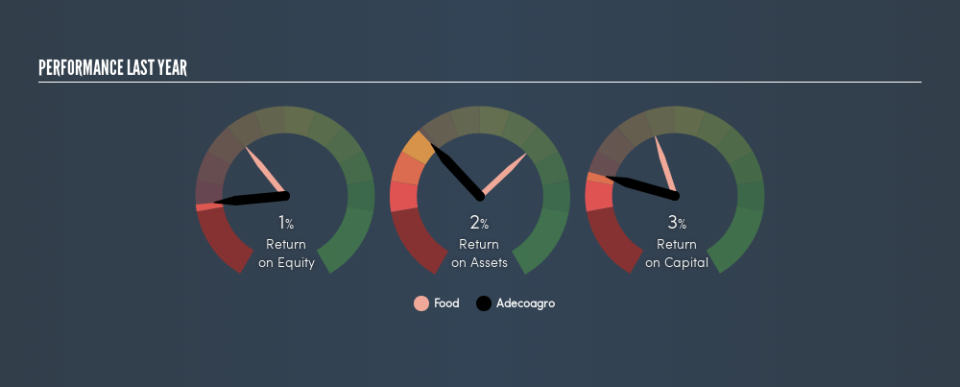Here’s why Adecoagro S.A.’s (NYSE:AGRO) Returns On Capital Matters So Much

Today we are going to look at Adecoagro S.A. (NYSE:AGRO) to see whether it might be an attractive investment prospect. Specifically, we'll consider its Return On Capital Employed (ROCE), since that will give us an insight into how efficiently the business can generate profits from the capital it requires.
First, we'll go over how we calculate ROCE. Then we'll compare its ROCE to similar companies. Then we'll determine how its current liabilities are affecting its ROCE.
What is Return On Capital Employed (ROCE)?
ROCE is a measure of a company's yearly pre-tax profit (its return), relative to the capital employed in the business. In general, businesses with a higher ROCE are usually better quality. In brief, it is a useful tool, but it is not without drawbacks. Renowned investment researcher Michael Mauboussin has suggested that a high ROCE can indicate that 'one dollar invested in the company generates value of more than one dollar'.
How Do You Calculate Return On Capital Employed?
The formula for calculating the return on capital employed is:
Return on Capital Employed = Earnings Before Interest and Tax (EBIT) ÷ (Total Assets - Current Liabilities)
Or for Adecoagro:
0.031 = US$68m ÷ (US$2.6b - US$369m) (Based on the trailing twelve months to June 2019.)
Therefore, Adecoagro has an ROCE of 3.1%.
View our latest analysis for Adecoagro
Does Adecoagro Have A Good ROCE?
When making comparisons between similar businesses, investors may find ROCE useful. We can see Adecoagro's ROCE is meaningfully below the Food industry average of 8.2%. This could be seen as a negative, as it suggests some competitors may be employing their capital more efficiently. Putting aside Adecoagro's performance relative to its industry, its ROCE in absolute terms is poor - considering the risk of owning stocks compared to government bonds. There are potentially more appealing investments elsewhere.
Adecoagro's current ROCE of 3.1% is lower than 3 years ago, when the company reported a 9.8% ROCE. Therefore we wonder if the company is facing new headwinds. You can click on the image below to see (in greater detail) how Adecoagro's past growth compares to other companies.
When considering this metric, keep in mind that it is backwards looking, and not necessarily predictive. ROCE can be deceptive for cyclical businesses, as returns can look incredible in boom times, and terribly low in downturns. ROCE is only a point-in-time measure. Since the future is so important for investors, you should check out our free report on analyst forecasts for Adecoagro.
Do Adecoagro's Current Liabilities Skew Its ROCE?
Current liabilities are short term bills and invoices that need to be paid in 12 months or less. The ROCE equation subtracts current liabilities from capital employed, so a company with a lot of current liabilities appears to have less capital employed, and a higher ROCE than otherwise. To check the impact of this, we calculate if a company has high current liabilities relative to its total assets.
Adecoagro has total liabilities of US$369m and total assets of US$2.6b. Therefore its current liabilities are equivalent to approximately 14% of its total assets. This is a modest level of current liabilities, which will have a limited impact on the ROCE.
The Bottom Line On Adecoagro's ROCE
That's not a bad thing, however Adecoagro has a weak ROCE and may not be an attractive investment. Of course, you might also be able to find a better stock than Adecoagro. So you may wish to see this free collection of other companies that have grown earnings strongly.
If you like to buy stocks alongside management, then you might just love this free list of companies. (Hint: insiders have been buying them).
We aim to bring you long-term focused research analysis driven by fundamental data. Note that our analysis may not factor in the latest price-sensitive company announcements or qualitative material.
If you spot an error that warrants correction, please contact the editor at editorial-team@simplywallst.com. This article by Simply Wall St is general in nature. It does not constitute a recommendation to buy or sell any stock, and does not take account of your objectives, or your financial situation. Simply Wall St has no position in the stocks mentioned. Thank you for reading.

